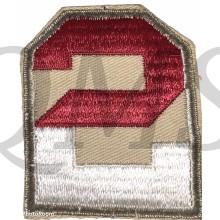Mouwembleem 2nd army zomer (Sleeve patch 2nd army summer)
Second United States Army was originally formed 15 October 1918 during World War I. It functioned as a training and administrative headquarters until being deactivated 15 April 1919. It operated 1933 to 1966, training and organizing troops for overseas deployment during World War II. It later operated under U.S. Army Forces
Second United States Army was reactivated on 1 October 1933 under a plan developed by then-Army Chief of Staff Douglas MacArthur to consolidate forces in the continental United States under four regional army commands.[2] It was headquartered in Memphis, Tennessee. In 1940, with the activation of Army General Headquarters (succeeded by Army Ground Forces in 1942), the four field armies were given responsibility for training forces in their respective areas and conducting maneuvers to evaluate training and readiness. In September 1941, Second U.S. Army participated in large-scale maneuvers pitting it against Third United States Army in what were known as the Louisiana Maneuvers.[3] Over 350,000 troops took part. Also in 1941, four regional defense commands were established coterminous with the army areas, and the Commander, Second U.S. Army became also Commanding General, Central Defense Command.
With First and Fourth Armies given primary responsibility for defense of the eastern and western coasts of the United States, and later with First Army's relocation to England to command U.S. Army forces in the invasion of France, Second and Third Armies assumed increasing responsibility for the training and organization of the rapidly expanding army and preparing troops for overseas deployment. When Third Army headquarters was relocated to France in 1944 to serve as a combat command, Second Army assumed its stateside responsibilities as well.
Second U.S. Army was commanded from 1940 to 1943 by Lt. Gen. Ben Lear. He was succeeded by Lt. Gen. Lloyd Fredendall after Fredendall's removal from command in North Africa. General Fredendall held command until war's end.



